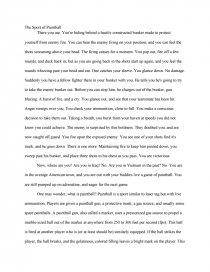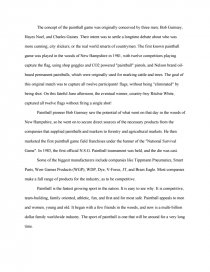The Sport of Paintball
Essay by review • December 4, 2010 • Research Paper • 2,528 Words (11 Pages) • 1,953 Views
The Sport of Paintball
There you are. You're hiding behind a hastily constructed bunker made to protect yourself from enemy fire. You can hear the enemy firing on your position, and you can feel the shots screaming above your head. The firing ceases for a moment. You pop out, fire off a few rounds, and duck back in; but as you are going back in the shots start up again, and you feel the rounds whizzing past your head and ear. One catches your sleeve. You glance down. No damage. Suddenly you have a fellow fighter there in your bunker with you. He tells you he's going to try to take the enemy bunker out. Before you can stop him, he charges out of the bunker, gun blazing. A burst of fire, and a cry. You glance out, and see that your teammate has been hit. Anger sweeps over you. You check your ammunition; close to full. You make a conscious decision to take them out. Taking a breath, you burst from your haven at speeds you did not know you could achieve. The enemy is surprised by this boldness. They doubted you, and are now caught off guard. You fire upon the exposed enemy. You see one of your shots find it's mark, and he goes down. There is one more. Maintaining fire to keep him pinned down, you sweep past his bunker, and place three shots in his chest as you pass. You are victorious.
Now, where are you? Are you in Iraq? No. Are you in Vietnam in the past? No. You are in the average American town, and you are out with your buddies live a game of paintball. You are still pumped up on adrenaline, and eager for the next game.
One may wonder, what is paintball? Paintball is a sport similar to laser tag but with live ammunition. Players are given a paintball gun, a protective mask, a gas source, and usually some spare paintballs. A paintball gun, also called a marker, uses a pressurized gas source to propel a marble-sized ball out of the marker at anywhere from 250 to 300 feet per second (fps). This ball is fired at another player who is (or at least should be) similarly equipped. If the ball strikes the player, the ball breaks, and the gelatinous, colored filling leaves a bright mark on the player. This is called being "marked". The player who was hit is usually out of the game at this point. Some people play multiple hit rules, such as three-hits-and-you're-out, or scenarios like that. This is a basic overview of the sport of paintball.
Now we shall look at the aforementioned items in more detail. First of all, the paintball gun. Most paintball guns, or markers, look vaguely similar to real firearms. The basic design is similar to a firearm, much like a large pistol. There are a few paintball markers that are held in the style of a rifle, like the Tippmann A-5, Pro/Carbine, or the Armotech SIM-4. But for the most part, markers are built like a large pistol. There are also paintball markers that look like a true pistol, and the differences will be explained shortly. The barrel of a paintball marker is approximately .68 calibers, although it can vary a slight amount depending on the manufacturer. The barrel is connected to the chamber, which holds the paintball inside the marker as it is about to be fired. When the trigger is pulled, high-pressure gas is released into the chamber, pushing the ball forward at very high speeds. The ball travels down and out of the barrel, in whatever direction the marker is pointing. Most paintball markers have the air connected in what is called a "bottomline" setup, where the gas hose comes out of the marker a short distance in front of the trigger assembly, and down to the bottom of the grip. This makes the marker easier to hold because it allows the use of the C02 tank as a stock to brace against one's shoulder. Most of the paintball markers styled as true pistols use a much smaller, disposable C02 cartridge, no bottomline and hold a limited number of rounds.
Secondly, the paintball mask. A paintball mask is a mask specially designed for the sport of paintball. It has a clear lens, similar to safety goggles. Below that, and connected to the lens, is a mouth and lower face guard. It goes down approximately to the chin, down around the cheeks, and continues back to protect the ears. These masks are not recommended they are required. Due to the high velocities of paintballs, this protection is the only mandatory protection that a player needs. Anything other than that is up to the player. If a paintball were to strike another player with no mask in the eye, it would almost certainly cause the eye to rupture, causing blindness in that eye. A hit to the ear, could rupture the eardrum, causing temporary or permanent deafness in that ear. A hit to the mouth could cause a person's teeth to tear through their lip to the outside. All of these things have happened before. All could have been prevented had a mask been worn. There are several kinds of lenses that can be used. The most common kind is a single, clear lens, made of high-strength clear plastic. This is the least expensive and easiest to clean. Glass is not used for lenses due to risk of breakage and resulting eye damage. There are also colored or tinted lenses. These act like wearing a pair of sunglasses while playing. The second type is the thermal lens. This is a double lens made to prevent the lens from clouding up. Lenses cloud up due to condensation from the heat of your body on the lens. It would be like breathing closely at a mirror and seeing it fog up. Thermal lenses do not fog thus eliminating the problem.
Next, we move onto the gas source. There are two power sources for paintball markers. Carbon Dioxide, almost always referred to in the sport, as it's common chemical name, C02. The other form is High Pressure Air (HPA). Both are stored in specialized tanks made to hold that particular gas. The most common kind is C02. When C02 is in it's tank, it is in liquid state. As the liquid C02 evaporates, tremendous pressure builds up. The pressure in a C02 tank is usually around 800 psi (pounds per square inch). As the marker is fired, the pressurized gas is released, allowing room for more C02 to evaporate, and for the pressure to build back up. This evaporation and pressure build is almost instantaneous, except when the C02 starts to run out. The problem with C02, for serious players, is that if one fires the marker very quickly, the C02 evaporation cannot always catch up quite as fast. This results in the marker's firing pressure dropping, and the ball not going as far or as fast. This only occurs at high rates of fire, such as 10 balls per second (bps) or more. The fast fire rate must be maintained for a time before the pressure drop will begin.
This problem was solved with the introduction of HPA. HPA is much more consistent than C02 simply because it is not stored in liquid form, thus there is no need for evaporation time. The air
...
...






